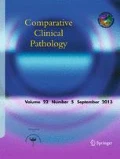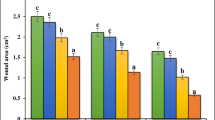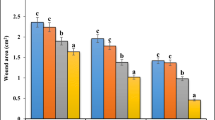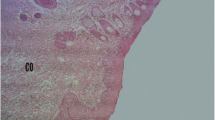Abstract
Cutaneous wound healing by medicinal plants which have fewer side effects than chemical drugs have been on the increase. In our study, we evaluated cutaneous wound healing potential of Allium eriophyllum Boiss aqueous extract ointment in rats. In in vivo design, after creating the cutaneous wound on the back of the rats, the animals were randomly divided into four groups: untreated control, treatment with Eucerin ointment, treatment with 3% tetracycline ointment, treatment with 3% A. eriophyllum aqueous extract ointment. The groups were treated for 30 days. For biochemical and histopathological analysis of the cutaneous wound healing trend, a 3 × 3 cm section was prepared from all dermal thicknesses on days 10, 20, and 30. The data were analyzed by SPSS 21 software. The use of A. eriophyllum aqueous extract ointment in the treatment groups led to remarkable reduce (p < 0.05) in the levels of wound area, total cells, neutrophil, lymphocyte, and macrophage, and remarkable increase (p < 0.05) in the levels of wound contracture, hydroxyl proline, hexosamine, hexuronic acid, fibrocyte, and the rate of fibrocyte to fibroblast as compared to the control and basal ointment groups. According to the findings, A. eriophyllum aqueous extract ointment can cure the cutaneous wound.













Similar content being viewed by others
References
Azhdari-Zarmehri H, Nazemi S, Ghasemi E, Musavi Z, Tahmasebi Z, Farsad F, Farzam A (2014) Assessment of effect of hydro-alcoholic extract of Scrophularia striata on burn healing in rat. JBUMS 16(5):42–48
Bitter T, Muir HM (1962) A modified uronic acid carbazole reaction. Anal Biochem 4(4):330–334
Caetano GF, Fronza M, Leite MN, Gomes A, Frade MAC (2016) Comparison of collagen content in skin wounds evaluated by biochemical assay and by computer-aided histomorphometric analysis. Pharm Biol 54(11):2555–2559
Dastmalchi K, Damien DH, Oinonena P, Darwisd Y, Laaksoa I, Hiltunen R (2008) Chemical composition and in vitro antioscidative activity of a lemon balm (Melissa Officinaliss L.) extract. LWT Food Sci Technol 41:391–400
Dong Y-L, Fleming RYD, Yan TZ, Herndon DN, Waymack JP (1993) Effect of ibuprofen on the inflammatory response to surgical wounds. J Trauma 35(3):340–343
Dwivedi D, Dwivedi M, Malviya S, Singh V (2017) Evaluation ofwound healing, anti-microbial and antioxidant potential of Pongamia pinnata in wistar rats. J Tradit Complement Med 7(1):79–85
Foroughi A, Zangeneh MM, Zangeneh A, Kazemi N (2016) A survey on antibacterial activities of Allium eriophyllum alcoholic extract: an ethnomedicinal plant. Iran J Public Health 45(2):32–32
Foschi D, Trabucchi E, Musazzi M, Castoldi L, Di Mattia D, Radaelli E, Marazzi M, Franzini P, Berlusconi A (1988) The effects of oxygen free radicals on wound healing. Int J Tissue React 10(6):373–379
Geethalakshmi R, Sakravarthi C, Kritika T, Arul Kirubakaran M, Sarada DVL (2013) Evaluation of antioxidant and wound healing potentials of Sphaeranthus amaranthoides Burm.f. Biomed Res Int 2013:607109
Ghashghaii A, Hashemnia M, Nikousefat Z, Zangeneh MM, Zangeneh A (2017) Wound healing potential of methanolic extract of Scrophularia striata in rats. Pharm Sci 23(4):256–263
Goodarzi N, Zangeneh MM, Zangeneh A (2018) The effect of ethanolic extract of Allium saralicum R.M. Fritsch on diabetic hepatopathy in male mice. Sci Res J Shahed Uni 25:21–30
Goorani S, Zangeneh MM, Koohi MK, Seydi N, Zangeneh A, Souri N, Hosseini MS (2018) Assessment of antioxidant and cutaneous wound healing effects of Falcaria vulgaris aqueous extract in Wistar male rats. Comp Clin Pathol 28:435–445. https://doi.org/10.1007/s00580-018-2866-3
Goorani S, Shariatifar N, Seydi N, Zangeneh A, Moradi R, Tari B, Nazari F, Zangeneh MM (2019) The aqueous extract of Allium saralicum 1 R.M. Fritsch effectively treat induced anemia. Experimental study on Wistar rats. Orient Pharm Exp Med. https://doi.org/10.1007/s13596-019-00361-5
Guo S, DiPietro LA (2010) Factors affecting wound healing. J Dent Res 89(3):219–229
Hagh-Nazari L, Goodarzi N, Zangeneh MM, Zangeneh A, Tahvilian R, Moradi R (2017) Stereological study of kidney in streptozotocininduced diabetic mice treated with ethanolic extract of Stevia rebaudiana (bitter fraction). Comp Clin Pathol 26(2):455–463
Hamelian M, Zangeneh MM, Amisama A, Varmira K, Veisi H (2018) Green synthesis of silver nanoparticles using Thymus kotschyanus extract and evaluation of their antioxidant, antibacterial and cytotoxic effects. Appl Organomet Chem 32(9):e4458
Hosseinkhani A, Falahatzadeh M, Raoofi E, Zarshenas MM (2016) An evidence-based review on wound healing herbal remedies from reports of traditional Persian medicine. J Evid Based Complementary Altern Med 22(2):334–343
Janahmadi Z, Nekooeian AA, Mozafari M (2015) Hydroalcoholic extract of Allium eriophyllum leaves attenuates cardiac impairment in rats with simultaneous type 2 diabetes and renal hypertension. Res Pharm Sci 10(2):125–133
Khorasgni A, Karimi AH, Nazem MR (2010) A Comparision of healing effects of propolis and silver sulfadia Zine on full thickness skin wounds in rats. Pak Vet J 30(2):72–740
Koh TJ, DiPietro LA (2011) Inflammation and wound healing: the role of the macrophage. Expert Rev Mol Med 13:e23
Kumar B, Vijaykumar M, Govindarajan R, Pushpangadan P (2008) Ethnopharmacological approaches to wound healing. Exploring medicinal plants of India. J Ethnopharmacol 12(8):103–110
Lazarus GS, Cooper DM, Knighton DR, Margolis DJ, Pecoraro RE, Rodeheaver G, Robson MC (1994) Definitions and guidelines for assessment of wounds and evaluation of healing. Arch Dermatol 130(4):489–493
Malekzadeh F (1986) Antimicrobial activity of Lawsonia inermis L. Appl Microbiol 16(4):663–664
Moradi R, Hajialiani M, Salmani S, Almasi M, Zangeneh A, Zangeneh MM (2018) Effect of aqueous extract of Allium saralicum R.M. Fritsch on fatty liver induced by high-fat diet in Wistar rats. Comp Clin Pathol. https://doi.org/10.1007/s00580-018-2834-y
Mozafari M, Nekooeian AA, Janahmadi Z (2015) The antihypertensive effects of hydroalcoholic extract of allium eriophyllum in leaves in rats with simultaneous type 2 diabetes and renal hypertension. Int Cardiovasc Res J 9(1):34–40
Mussel O, Saliva S, Costa A (2003) Mast cell in tissue response to density materials: an adhesive resin, a calcium hydroxide and a glass ionomer cement. J Cell Mol Med 7(2):171–173
Nayak BS, Isitor G, Davis EM, Pillai GK (2007) The evidence based wound healing activity of Lawsonia inermis Linn. Phytother Res 21(9):827–831
Oryan A, Tabatabaiei Naieni A, Moshiri A, Mohammadalipoor A, Tabandeh MR (2012) Modulation of cutaneous wound healing by Silymarin in rats. J Wound Care 21(9):457–464
Phillips GD, Whitehe RA, Kinghton DR (1991) Initiation and pattern of angiogenesis in wound healing in the rats. Am J Anat 192(3):257–262
Rezvanipour M, Pourzadehhosseini F, Malekpour R, Zarabi A (2007) The effect of mummy on some indices of wound healing in mice. J of Kerman Univ of Med Sci 14(4):77–267
Robards K, Prenzler PD, Tucker G, Swatsitang P, Glover W (1999) Phenolic compounds and their role in oxidative processes in fruits. Food Chem 66(4):401–436
Sayyedrostami T, Pournaghi P, Ebrahimi Vosta-Kalaeea S, Zangeneh MM (2018) Evaluation of the wound healing activity of Chenopodium botrys leaves essential oil in rats (a short-term study). J Essent Oil Bear Pl 21(1):164–174
Shakibaie D, Pasharavesh L, Khoshboo S, Kaboodi B (2007) The effect of the “Falcaria Vulgaris” on deep skin wound remodeling time and skin tension power in rats. J Kermanshah Univ Med Sci 10(3):187–194
Sherkatolabbasieh H, Hagh-Nazari L, Shafiezadeh S, Goodarzi N, Zangeneh MM, Zangeneh A (2017) Ameliorative effects of the ethanolic extract of Allium saralicum R.M. Fritsch on CCl4-induced nephrotoxicity in mice: a stereological examination. Arch Biol Sci 69(3):535–543
Souba WW, Wilmore D (1999) Diet and nutrition in case of the patient with surgery. 9th Ed. Williams and Wilkins Press, Baltimore, pp 1589–1618
Zangeneh MM, Goodarzi N, Zangeneh A, Tahvilian R, Najafi F (2018a) Amelioration of renal structural changes in STZ-induced diabetic mice with ethanolic extract of Allium saralicum R.M. Fritsch. Comp Clin Pathol 27(4):861–867
Zangeneh MM, Zangeneh A, Tahvilian R, Moradi R (2018b) Antidiabetic, hematoprotective and nephroprotective effects of the aqueous extract of Falcaria vulgaris in diabetic male mice. Arch Bio Sci 70(4):655–664
Zangeneh MM, Zangeneh A, Tahvilian R, Moradi R, Zhaleh H, Amiri-Paryan A, Bahrami E (2018c) Hepatoprotective and hematoprotective effects of Falcaria vulgaris aqueous extract against CCl4-induced hepatic injury in mice. Comp Clin Pathol 27:1359–1365. https://doi.org/10.1007/s00580-018-2747-9
Author information
Authors and Affiliations
Corresponding author
Ethics declarations
Conflict of interest
The authors declare that they have no conflict of interest.
Ethic approval
All institutional and national guidelines for the care and use of laboratory animals were followed.
Additional information
Publisher’s note
Springer Nature remains neutral with regard to jurisdictional claims in published maps and institutional affiliations.
Rights and permissions
About this article
Cite this article
Goorani, S., Morovvati, H., Zangeneh, M.M. et al. Experimental study on Wistar rats: the Allium eriophyllum Boiss aqueous extract ointment effectively treat induced cutaneous wound. Comp Clin Pathol 28, 1431–1438 (2019). https://doi.org/10.1007/s00580-019-02986-z
Received:
Accepted:
Published:
Issue Date:
DOI: https://doi.org/10.1007/s00580-019-02986-z




